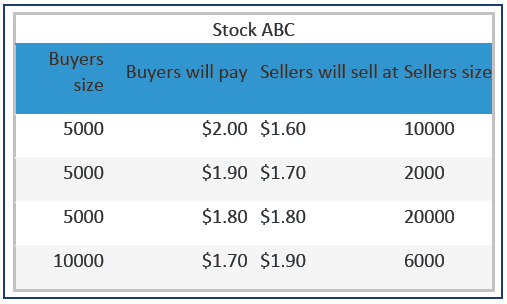Between the hours of 5:30pm and 9am (NZT), the Cash Markets are in their Enquiry state. This simply means that markets are “read-only” – orders can’t be entered, deleted, or amended in any way.
At 9am, the market enters its Pre-Open Session. In Pre-Open, you can do anything except trade – you can place, delete and amend orders, as well as report trades that have been negotiated outside of trading hours.
This Pre-Open session is the prelude to the opening auction (described below). During this session, you will often see overlapping bids and offers – ie, buy prices which are higher than sell prices. This cannot happen during the regular trading session, as, as soon as a buyer places a buy order at, or above, a price level at which a seller is already offering, a trade occurs. Prices cannot overlap. However, as no trades occur during the Pre-Open session until the opening auction it is common to see bid-offer overlap during this session. In fact, if there is no price overlap in a stock, there will be no trades in the opening auction.
The Opening Auction occurs at a random time 30 seconds either side of 10:00am (ie, at a random time between 09:59:30 and 10:00:30). The opening auction is a single price print which becomes the official opening price of the day. If there are no trades in a stock in the opening auction, the first sale during the regular session (see below) becomes the official opening price for the day.
The opening auction algorithm calculates the opening price by surveying all the overlapping bids and offers in the stock at the time of the auction, and calculating the single price point at which the most volume will trade.
A simple example will illustrate.

The algorithm will ‘say to itself’: “There is a buyer prepared to buy 5,000 shares at $2.00, and there are multiple sellers prepared to sell a total of 38,000 shares at this $2.00 price or lower, hence, if I opened the stock at $2.00, a total of 5,000 shares would trade”.
“There are two buyers prepared to buy a total of 10,000 shares at $1.90 or above, and there are multiple sellers prepared to sell at total of 38,000 shares at this $1.90 price or lower, hence, if I opened the stock at $1.90, a total of 10,000 shares would trade.”
It would them perform this same exercise at $1.80, $1.70, and $1.60, and work out at which price it could clear the most volume, thus:
“If I opened the stock at…”
$2.00, 5,000 would trade.
$1.90, 10,000 would trade.
$1.80, 15,000 would trade.
$1.70, 12,000 would trade.
$1.60, 10,000 would trade.
Hence, in this situation, the opening auction print would be 15,000 shares at $1.80, as this is the price at which the maximum volume would trade. This price would be the official opening price on the day.
Once the opening auction has completed, the market goes in to its Continuous or Regular Trading Session. This is the session that most people recognize as the market trading session. Bids and Offers can be placed, amended and deleted, on-market trades can occur (if a bid price and an offer price “meet”), and off-market trades can be reported to market. This session is continuous – with no breaks – from 10:00am until 4:45pm every trading day, and is the session in which most trading occurs.
At 4:45pm, the market enters its Pre-Close Session. The Pre-Close session is virually the same as the Pre-Open session – it just occurs at a different time of the day. In Pre-Close, you can place, delete and amend orders, but you cannot report off-market trades. Any off-market orders negotiated during this time must be reported during the Adjust session (see below).
The Closing Auction occurs at a random time 30 seconds either side of 5:00pm (ie, at any time between 16:59:30 and 17:00:30). Like the opening auction, the closing auction is a single price print which becomes the official close of the stock on the day. If there are no trades in a stock in the closing auction, the last sale during the regular session becomes the official closing price for the day.
The Closing Auction algorithm is exactly the same as that used in the Opening Auction. It will compute the price at which it can clear the greatest amount of stock, and all bids and offers at, and overlapping, this level will execute at this, single, closing print price.
After the Closing Auction print, the market enters its Adjust Session. In this session, orders can be amended, but not improved (ie bid prices can be reduced and offer prices moved higher, but not the converse, and order sizes can be reduced but not increased). Existing orders can be cancelled, but new orders cannot be placed into the market. Off-market trades can be reported.
At 5:30pm, the market re-enters its Enquiry State, and the whole cycle starts again.
For more information see: nzx.com/investing/nzxtrading-hours